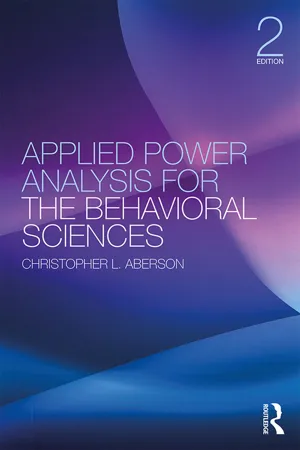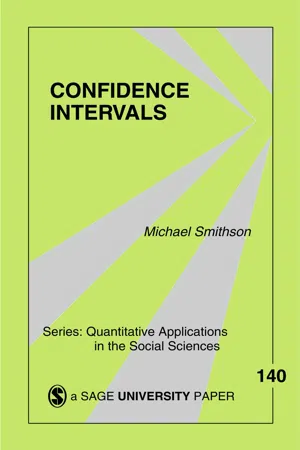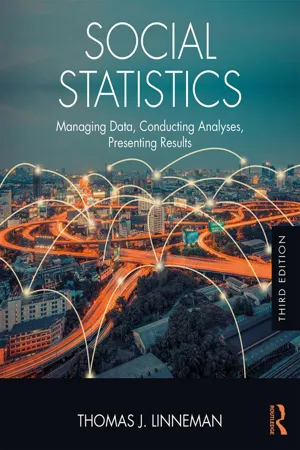Confidence Interval for the Difference of Two Means
A confidence interval for the difference of two means is a statistical range that provides an estimate of the true difference between the means of two populations. It is calculated using sample data and a specified level of confidence, allowing researchers to make inferences about the population means. This interval helps to quantify the uncertainty associated with the difference in means.
8 Key excerpts on "Confidence Interval for the Difference of Two Means"
- eBook - ePub
- Christopher L. Aberson(Author)
- 2019(Publication Date)
- Routledge(Publisher)
...Both examples reflect the same data but the CI presentation clearly suggests limited confidence regarding the size of the differences between the two groups. A narrower CI (e.g., ranging from 1.5 to 2.1) supports a stronger conclusion about how much the groups likely differ in the population. Precision analysis allows for determination of sample size requirements that produce confidence limits of a desired width. Types of Confidence Intervals Interval estimates around mean differences are included in most statistical packages. Constructing this sort of interval requires taking the differences between two sample means plus or minus margin of error. For example, for the CI around the difference between two means, the margin of error involves a t -statistic corresponding to the confidence level multiplied by an index of standard error. Intervals of this type are often termed central intervals as their calculation involves the central t -distribution. Less commonly presented are interval estimates around effect sizes (e.g., Thompson, 2002). Use of such values fits nicely with recommendations to present effect sizes and confidence limits (e.g., Wilkinson & Task Force on Statistical Inference, 1999), so presentation of these values to should become increasingly common (although they have not in the period between the first edition of the book and the present edition). A CI around an effect size yields information about likely values for the effect size in the population. This concept is appealing as it opens the door to determining what effect sizes are likely or unlikely for the population. For example, a CI of 0.40 to 0.80 drawn around an observed effect size d suggests that it would be unlikely for the standardized difference between means in the population to be smaller than 0.40. CIs around effect sizes require specialized calculations because these intervals involve noncentral distributions that require iterative procedures to achieve accurate calculations...
- eBook - ePub
- Lawrence S. Aft(Author)
- 2018(Publication Date)
- CRC Press(Publisher)
...A 95 percent confidence interval would be even wider — for example, between 722.49 and 741.51.) A confidence interval is a range of values that has a specified likelihood of including the true value of a population parameter. It is calculated from sample calculations of the parameters. There are many types of population parameters for which confidence intervals can be established. Those important in quality control applications include means, proportions (percentages), and standard deviations. Confidence intervals are generally presented in the following format: Point estimate of the population parameter ± (Confidence factor) (Measure variability) (Adjusting factor) A number of formulas have been developed for particular cases. The remaining sections of this chapter will present, illustrate, and interpret these formulas as they relate to quality control. Confidence Intervals for Means The way a confidence interval for means is developed depends on the sample size. As noted earlier, the larger the sample size, the better the estimate. Statistically, large samples are arbitrarily defined as those with 30 or more members. Small samples have fewer than 30 members. Either a z value or a t value is needed to represent the level of significance in confidence interval formulas when one is dealing with averages. Other probability distributions are used when dealing with confidence intervals for other statistics, such as standard deviations. z Values For large samples, the standard normal curve is used to specify the confidence. The value corresponding to the confidence is the z value. Example 5.1 What z value corresponds to an α of.05 or 95 percent confidence? Solution We are looking at a confidence interval for which the area outside the interval is symmetrically distributed...
- Richard Kay(Author)
- 2014(Publication Date)
- Wiley(Publisher)
...We had an observed difference in the sample means of 1.4 mmol/l and a standard error of 0.29 mmol/l. The formula for the 95 per cent confidence interval for the difference between two means (μ 1 − μ 2) is This expression is essentially the same as that for a single mean: statistic ±(constant × se). The rules for obtaining the multiplying constant however are slightly different. For the difference between two means, we use Table 3.1 as before, but now, we go into that table at the row n 1 + n 2 − 2, where n 1 and n 2 are the sample sizes for treatment groups 1 and 2, respectively. So for our data (n 1 = 24 and n 2 = 23), the multiplying constant (from row 45) is 2.01 and the calculation of the 95 per cent confidence interval is as follows: The interpretation of this interval is essentially as before; we can be 95 per cent confident that the true difference in the (population) means, μ 1 − μ 2, is between 0.8 and 2.0. In other words, these data are telling us with 95 per cent confidence that the mean reduction μ 1 in the active group is greater than the corresponding mean reduction μ 2 in the placebo group by between 0.8 mmol/l and 2.0 mmol/l. 3.2.2 Confidence interval for proportions The previous sections in this chapter are applicable when we are dealing with means. As noted earlier, these parameters are relevant when we have continuous, count or score data. With binary data, we will be looking to construct confidence intervals for rates or proportions plus differences between those rates. Example 3.2 Trastuzumab in HER2-positive breast cancer The following data (Table 3.4) are taken from Piccart-Gebhart et al. (2005) who compared trastuzumab after adjuvant chemotherapy in HER2-positive breast cancer with observation-only. The binary outcome here is one or more serious adverse events (SAEs) versus no SAEs during the one-year trial...
- eBook - ePub
- Mustapha Abiodun Akinkunmi(Author)
- 2019(Publication Date)
- De Gruyter(Publisher)
...In most cases, we use a 95% confident limit for the estimation—this implies that we can say that our estimation about a population plausibly falls within the specified range of values in 95 out of 100 cases. For instance, a researcher may like to know the number of cars traveling a road on a daily basis. A traffic study over several days concludes that the average number of cars traveling a road daily is between 180 and 200. This scenario can be represented as the normal curve shown in Figure 9.1. Figure 9.1: Confidence interval of the average number of cars traveling a road daily. 9.2 Confidence Intervals for Mean If a sample is drawn many times, there is a certain percentage of assurance that a range of values computed from the sample will probably contain an unknown population parameter—this percentage is the confidence interval. A confidence interval is the probability that a value will fall between the upper and lower bound of a probability distribution. Suppose an analyst forecasted that the return on the Dow Jones Industrial Average (DJIA) in the first quarter of the year will fall within -0.5% and +2.5% at a 95 percent confidence interval. This means that the analyst is 95% sure that the returns on the DJIA in the first quarter of the year will lie between -0.5% and +2.5%. Confidence intervals (CIs) can be used to bound numerous statistics such as the mean, proportion, and regression coefficients (Chapter 11). A confidence interval is constructed as follows: C I = s a m p l e s t a t i s t i c ± c r i t i c a l v a l u e × s t a n d a r d e r r o r o f e s t i m a t e For example, if the sample size n < 30, σ is unknown, and the population is normally distributed, then we should use the Student’s t-distribution...
- eBook - ePub
Statistical Misconceptions
Classic Edition
- Schuyler W. Huck(Author)
- 2015(Publication Date)
- Routledge(Publisher)
...For example, suppose a random sample from a population produced an X̄ = 50. The 95% confidence interval might range from 45 to 55. That is, the probability that the interval 45–55 includes μ is.95. Why This Misconception Is Dangerous Statistics is like many other academic disciplines in that it demands precision in the actions one takes and the interpretations one draws. In statistics, as in other fields, two things can look alike yet be different in how they were created and what they mean. For example, a single set of data can have a mean equal to 14.7 as well as a standard deviation that’s equal to 14.7. A knowledgeable person distinguishes between these two (identical) numbers by realizing that they were generated by different formulas and carry entirely different meanings. It is tempting to think that the probability is.95 that the population parameter lies somewhere within a 95% CI, and many people mistakenly draw this conclusion. Those who do this, however, fail to distinguish between two quite different statistical concepts: a confidence interval, on the one hand, and a credible interval, on the other. Despite the fact that these two kinds of intervals resemble each other in both form and purpose, they are not the same in terms of the formulas used to create them or the ways in which they should be interpreted. The danger associated with this misconception is that the person who interprets confidence intervals as if they were credible intervals will develop the habit of interpreting statistical results quickly in ways that seem to make intuitive sense (rather than interpreting such results in careful, precise ways that lead to valid thoughts and statements). Undoing the Misconception A 95% CI that has been built around a sample mean is a probability statement. It indicates that something has a probability of.95...
- eBook - ePub
- Michael Smithson(Author)
- 2002(Publication Date)
- SAGE Publications, Inc(Publisher)
...In exploratory research, confidence intervals provide information about the (im)precision of sample estimates. They also assist in the generation of hypotheses by displaying the range of plausible values for a parameter, which in turn informs the researcher about the relative plausibility of competing predictions regarding that parameter. Different disciplines have varied considerably in the extent to which confidence intervals are routinely reported in published research. Some of the social sciences have a long-standing tradition of using them, usually where the emphasis is on parameter estimation rather than hypothesis testing and often in the context of sample surveys. More experimentally oriented disciplines, on the other hand, traditionally have relied on significance tests and often eschewed confidence intervals altogether. This was the situation in medicine until about 10-15 years ago and still tends to be the case for psychology. The advantages that confidence intervals have over null-hypothesis significance testing have been presented on many occasions to researchers in psychology. Early exponents of this viewpoint include Rozeboom (1960) and Meehl (1967), and more recent ones are Oakes (1986) and Schmidt (1996). Several recent commentators have wondered why psychological researchers have clung to significance testing for so long. However, standard practices in psychology do appear likely to change at last, given the conclusions of the APA Task Force on Statistical Inference (Wilkinson & APA Task Force on Statistical Inference, 1999). The guidelines make their position quite clear: It is hard to imagine a situation in which a dichotomous accept–reject decision is better than reporting an actual p value or, better still, a confidence interval.… Interval estimates should be given for any effect sizes involving principal outcomes. Provide intervals for correlations and other coefficients of association or variation whenever possible (p...
- eBook - ePub
Social Statistics
Managing Data, Conducting Analyses, Presenting Results
- Thomas J. Linneman(Author)
- 2017(Publication Date)
- Routledge(Publisher)
...Here we’ll use a similar idea: we’ll allow a 5% chance that we could be wrong, but we want to be correct 95% of the time, thus the term “95% confidence interval.” Some people want to be more sure and want to allow only a 1% chance of error, so we will also cover, you guessed it, a 99% confidence interval. But we’ll start with 95%. So we can be wrong 5% of the time. In other words, we’re going to allow a 5% chance that the population mean falls outside of our confidence interval. We’re going to take that 5% and cut it into two parts: 2.5% and 2.5%. We’re going to use 2.5% for each of the following two scenarios: The population mean is higher than our sample mean. The population mean is lower than our sample mean. We’ll start with the first scenario: there’s a possibility that, although the GSS sample mean was 4.69, the population mean is higher than this. Visually, we have this: ■ Exhibit 5.27: A Sample Mean Lower than the Population Mean We want to figure out a value for the population mean that is a certain number of standard errors away such that a sample mean of 4.69 or less is likely to happen only 2.5% of the time. Basically, we’re going to reverse what we did when we had a claimed population mean: procedure with claimed population mean: actual distance → number of standard errors → percentage probability procedure with confidence intervals: percentage probability → number of standard errors → actual distance We already have our percentage probability, 2.5%, and we use the t -table to move from this to a number of standard errors. Under the column for 0.025, we go down to the row df = 15 (because we have 16 cases in our sample) and see that the number of standard errors is 2.13. The next step is to translate the number of standard errors into a meaningful distance. Earlier, we calculated the value of the standard error, and it was 0.75. We want 2.13 standard errors at a value of 0.75 each: 2.13 × 0.75 = 1.60...
- eBook - ePub
- Jean Cardinet, Sandra Johnson, Gianreto Pini(Authors)
- 2011(Publication Date)
- Routledge(Publisher)
...To do this we need the corresponding standard errors (of the mean or of the difference between means), which we can obtain by separately considering each group or pair of groups. It is also possible to calculate an overall error term (global, pooled) that can then be used to establish all the confidence intervals of interest, as follows: Standard error of the mean: SE(M) Independent samples Repeated measures samples Standard error of the difference between means: SE(D) Independent samples Repeated measures samples The standard error thus obtained (of the mean, or of the difference between means) can be considered as a kind of “average” standard error, and its use can be justified by the fact that, having been calculated on the basis of the whole set of available data (covering all the sample characteristics), it represents in principle a more stable (and hence more reliable) estimate of the parameter we are trying to establish. Confidence intervals are then classically defined in the following way: Confidence interval around a mean : Confidence interval for a difference between means : where L L/U represents the lower and upper limits of the interval, m is the sample mean (mean of one level of the Groups factor), d is the difference between the means of two samples, SE(M) is the standard error of the mean, SE(D) is the standard error of the difference between means, and z α is the critical value that captures the appropriate percentage of values within a Normal or Student distribution. It must be remembered, however, that in the case of repeated measures samples, the use of SE(M) and SE(D), calculated as shown earlier, is controversial. Admittedly, the term MS(SG) does not seem to pose major problems as far as the global variance analysis test is concerned...







